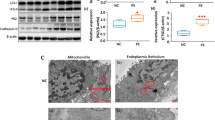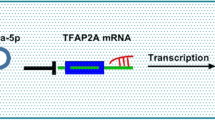Abstract
To investigate a possible association between miR-101 and apoptosis of human trophoblast cells mediated by endoplasmic reticulum protein 44 (ERp44) in preeclampsia (PE), we explored the expression of miR-101 in PE placentas (n=30) compared with normotensive pregnant placentas (n=30) and the correlation between miR-101 and ERp44 was also analyzed. Furthermore, both the apoptotic rate of trophoblast cells and the ER stress-induced apoptotic proteins were assayed when the HTR-8/SVneo cells were treated with miR-101 mimics or inhibitors in vitro. We found a lower expression of miR-101 and an inverse correlation between miR-101 and ERp44 protein in PE placentas. Upregulation of miR-101 expression could inhibit trophoblast HTR-8/SVneo cell apoptosis and repress ER stress-induced apoptotic proteins by targeting ERp44 in vitro, whereas inhibition of miR-101 could induce HTR-8/SVneo cell apoptosis. Our findings indicated that overexpression of miR-101 could downregulate ERp44 and suppress apoptosis in trophoblast cells during PE. Therefore, loss of miR-101 expression could contribute to ER stress-induced trophoblast cell apoptosis by targeting ERp44.
This is a preview of subscription content, access via your institution
Access options
Subscribe to this journal
Receive 12 digital issues and online access to articles
$119.00 per year
only $9.92 per issue
Buy this article
- Purchase on Springer Link
- Instant access to full article PDF
Prices may be subject to local taxes which are calculated during checkout




Similar content being viewed by others
References
Powe CE, Levine RJ, Karumanchi SA . Preeclampsia, a disease of the maternal endothelium: the role of antiangiogenic factors and implications for later cardiovascular disease. Circulation 2011; 123 (24): 2856–2869.
Askelund KJ, Chamley LW . Trophoblast deportation part I: review of the evidence demonstrating trophoblast shedding and deportation during human pregnancy. Placenta 2011; 32 (10): 716–723.
Sacks GP, Studena K, Sargent K, Redman CW . Normal pregnancy and preeclampsia both produce inflammatory changes in peripheral blood leukocytes akin to those of sepsis. Am J Obstet Gynecol 1998; 179 (1): 80–86.
Saftlas AF, Beydoun H, Triche E . Immunogenetic determinants of preeclampsia and related pregnancy disorders: a systematic review. Obstet Gynecol 2005; 106 (1): 162–172.
Conrad KP, Benyo DF . Placental cytokines and the pathogenesis of preeclampsia. Am J Reprod Immunol 1997; 37 (3): 240–249.
Granger JP, Alexander BT, Llinas MT, Bennett WA, Khalil RA . Pathophysiology of hypertension during preeclampsia linking placental ischemia with endothelial dysfunction. Hypertension 2001; 38 (3 Pt 2): 718–722.
Rana S, Karumanchi SA, Levine RJ, Venkatesha S, Rauh-Hain JA, Tamez H et al. Sequential changes in antiangiogenic factors in early pregnancy and risk of developing preeclampsia. Hypertension 2007; 50 (1): 137–142.
Lam C, Lim KH, Karumanchi SA . Circulating angiogenic factors in the pathogenesis and prediction of preeclampsia. Hypertension 2005; 46 (5): 1077–1085.
Noris M, Todeschini M, Cassis P, Pasta F, Cappellini A, Bonazzola S et al. L-arginine depletion in preeclampsia orients nitric oxide synthase toward oxidant species. Hypertension 2004; 43 (3): 614–622.
Walsh SW . Maternal-placental interactions of oxidative stress and antioxidants in preeclampsia. Semin Reprod Endocrinol 1998; 16 (1): 93–104.
Bartha JL, Romero-Carmona R, Torrejon-Cardoso R, Comino-Delgado R . Insulin, insulin-like growth factor-1, and insulin resistance in women with pregnancy-induced hypertension. Am J Obstet Gynecol 2002; 187 (3): 735–740.
Jain A, Olovsson M, Burton GJ, Yung HW . Endothelin-1 induces endoplasmic reticulum stress by activating the PLC-IP(3) pathway: implications for placental pathophysiology in preeclampsia. Am J Pathol 2012; 180 (6): 2309–2320.
Burton GJ, Yung HW . Endoplasmic reticulum stress in the pathogenesis of early-onset pre-eclampsia. Pregnancy Hypertens 2011; 1 (1-2): 72–78.
Yung HW, Calabrese S, Hynx D, Hemmings BA, Cetin I, Charnock-Jones DS et al. Evidence of placental translation inhibition and endoplasmic reticulum stress in the etiology of human intrauterine growth restriction. Am J Pathol 2008; 173 (2): 451–462.
Lin WC, Chuang YC, Chang YS, Lai MD, Teng YN, Su IJ et al. Endoplasmic reticulum stress stimulates p53 expression through NF-kappaB activation. PLoS ONE 2012; 7 (7): e39120.
Burton GJ, Jauniaux E . Placental oxidative stress: from miscarriage to preeclampsia. J Soc Gynecol Investig 2004; 11 (6): 342–352.
Sun LZ, Yang NN, De W, Xiao YS . Proteomic analysis of proteins differentially expressed in preeclamptic trophoblasts. Gynecol Obstet Invest 2007; 64 (1): 17–23.
Bartel DP . MicroRNAs: genomics, biogenesis, mechanism, and function. Cell 2004; 116 (2): 281–297.
Small EM, Olson EN . Pervasive roles of microRNAs in cardiovascular biology. Nature 2011; 469 (7330): 336–342.
Fineberg SK, Kosik KS, Davidson BL . MicroRNAs potentiate neural development. Neuron 2009; 64 (3): 303–309.
Weidhaas J . Using microRNAs to understand cancer biology. Lancet Oncol 2010; 11 (2): 106–107.
Forbes K, Farrokhnia F, Aplin JD, Westwood M . Dicer-dependent miRNAs provide an endogenous restraint on cytotrophoblast proliferation. Placenta 2012; 33 (7): 581–585.
Kota J, Chivukula RR, O'Donnell KA, Wentzel EA, Montgomery CL, Hwang HW et al. Therapeutic microRNA delivery suppresses tumorigenesis in a murine liver cancer model. Cell 2009; 137 (6): 1005–1017.
Gartner JJ, Sethupathy P, Hatzigeorgiou AG, Fraser NW . Anti-apoptotic function of a microRNA encoded by the HSV-1 latency-associated transcript. Nature 2008; 451 (7178): 600.
Geeleher P, Huang SR, Gamazon ER, Golden A, Seoighe C . The regulatory effect of miRNAs is a heritable genetic trait in humans. BMC Genomics 2012; 13: 383.
Follert P, Cremer H, Beclin C . MicroRNAs in brain development and function: a matter of flexibility and stability. Front Mol Neurosci 2014; 7: 5.
Bouyssou JM, Manier S, Huynh D, Issa S, Roccaro AM, Ghobrial IM . Regulation of microRNAs in Cancer Metastasis. Biochim Biophys Acta 2014; 1845 (2): 255–265.
Fernandez-Hernando C, Baldan A . MicroRNAs and cardiovascular disease. Curr Genet Med Rep 2013; 1 (1): 30–38.
Zhu XM, Han T, Sargent IL, Yin GW, Yao YQ . Differential expression profile of microRNAs in human placentas from preeclamptic pregnancies vs normal pregnancies. Am J Obstet Gynecol 2009; 200 (6): 661.
Kitroser E, Pomeranz M, Epstein SG, Fishman A, Drucker L, Sadeh-Mestechkin D et al. The involvement of eukaryotic translation initiation factor 4E in extravillous trophoblast cell function. Placenta 2012; 33 (9): 717–724.
Liu S, Li Q, Na Q, Liu C . Endothelin-1 stimulates human trophoblast cell migration through Cdc42 activation. Placenta 2012; 33 (9): 712–716.
Graham CH, Hawley TS, Hawley RG, MacDougall JR, Kerbel RS, Khoo N et al. Establishment and characterization of first trimester human trophoblast cells with extended lifespan. Exp Cell Res 1993; 206 (2): 204–211.
Trobaugh DW, Gardner CL, Sun C, Haddow AD, Wang E, Chapnik E et al. RNA viruses can hijack vertebrate microRNAs to suppress innate immunity. Nature 2014; 506 (7487): 245–248.
Su L, Liu R, Cheng W, Zhu M, Li X, Zhao S et al. Expression patterns of microRNAs in porcine endometrium and their potential roles in embryo implantation and Placentation. PLoS ONE 2014; 9 (2): e87867.
Pineles BL, Romero R, Montenegro D, Tarca AL, Han YM, Kim YM et al. Distinct subsets of microRNAs are expressed differentially in the human placentas of patients with preeclampsia. Am J Obstet Gynecol 2007; 196 (3): 261.
Muralimanoharan S, Maloyan A, Mele J, Guo C, Myatt LG, Myatt L . MIR-210 modulates mitochondrial respiration in placenta with preeclampsia. Placenta 2012; 33 (10): 816–823.
Dai Y, Qiu Z, Diao Z, Shen L, Xue P, Sun H et al. MicroRNA-155 inhibits proliferation and migration of human extravillous trophoblast derived HTR-8/SVneo cells via down-regulating cyclin D1. Placenta 2012; 33 (10): 824–829.
Zhang Y, Diao Z, Su L, Sun H, Li R, Cui H et al. MicroRNA-155 contributes to preeclampsia by down-regulating CYR61. Am J Obstet Gynecol 2010; 202 (5): 461–466.
Leung AK, Sharp PA . MicroRNA functions in stress responses. Mol Cell 2010; 40 (2): 205–215.
van Rooij E, Sutherland LB, Qi X, Richardson JA, Hill J, Olson EN . Control of stress-dependent cardiac growth and gene expression by a microRNA. Science 2007; 316 (5824): 575–579.
Flynt AS, Thatcher EJ, Burkewitz K, Li N, Liu Y, Patton JG . miR-8 microRNAs regulate the response to osmotic stress in zebrafish embryos. J Cell Biol 2009; 185 (1): 115–127.
Brennecke J, Hipfner DR, Stark A, Russell RB, Cohen SM . bantam encodes a developmentally regulated microRNA that controls cell proliferation and regulates the proapoptotic gene hid in Drosophila. Cell 2003; 113 (1): 25–36.
Whitley GS, Dash PR, Ayling LJ, Prefumo F, Thilaganathan B, Cartwright JE . Increased apoptosis in first trimester extravillous trophoblasts from pregnancies at higher risk of developing preeclampsia. Am J Pathol 2007; 170 (6): 1903–1909.
Longtine MS, Chen B, Odibo AO, Zhong Y, Nelson DM . Villous trophoblast apoptosis is elevated and restricted to cytotrophoblasts in pregnancies complicated by preeclampsia, IUGR, or preeclampsia with IUGR. Placenta 2012; 33 (5): 352–359.
Anelli T, Alessio M, Mezghrani A, Simmen T, Talamo F, Bachi A et al. ERp44, a novel endoplasmic reticulum folding assistant of the thioredoxin family. EMBO J 2002; 21 (4): 835–844.
Moenner M, Pluquet O, Bouchecareilh M, Chevet E . Integrated endoplasmic reticulum stress responses in cancer. Cancer Res 2007; 67 (22): 10631–10634.
Hamada K, Miyata T, Mayanagi K, Hirota J, Mikoshiba K . Two-state conformational changes in inositol 1,4,5-trisphosphate receptor regulated by calcium. J Biol Chem 2002; 277 (24): 21115–21118.
Choe CU, Ehrlich BE . The inositol 1,4,5-trisphosphate receptor (IP3R) and its regulators: sometimes good and sometimes bad teamwork. Sci STKE 2006; 2006 (363): e15.
Marks AR . Intracellular calcium-release channels: regulators of cell life and death. Am J Physiol 1997; 272 (2 Pt 2): H597–H605.
Peter ME . Targeting of mRNAs by multiple miRNAs: the next step. Oncogene 2010; 29 (15): 2161–2164.
Acknowledgements
This study was supported by The National Natural Science Foundation of China, Grant Nos 81070511 and 81270710.
Author information
Authors and Affiliations
Corresponding author
Ethics declarations
Competing interests
The authors declare no conflict of interest.
Rights and permissions
About this article
Cite this article
Zou, Y., Jiang, Z., Yu, X. et al. MiR-101 regulates apoptosis of trophoblast HTR-8/SVneo cells by targeting endoplasmic reticulum (ER) protein 44 during preeclampsia. J Hum Hypertens 28, 610–616 (2014). https://doi.org/10.1038/jhh.2014.35
Received:
Revised:
Accepted:
Published:
Issue Date:
DOI: https://doi.org/10.1038/jhh.2014.35
This article is cited by
-
Silencing of LncRNA SNHG6 protects trophoblast cells through regulating miR-101-3p/OTUD3 axis in unexplained recurrent spontaneous abortion
Journal of Molecular Histology (2022)
-
Roles of noncoding RNAs in preeclampsia
Reproductive Biology and Endocrinology (2021)
-
ERO1α mediates endoplasmic reticulum stress-induced apoptosis via microRNA-101/EZH2 axis in colon cancer RKO and HT-29 cells
Human Cell (2021)
-
MiR-101-containing extracellular vesicles bind to BRD4 and enhance proliferation and migration of trophoblasts in preeclampsia
Stem Cell Research & Therapy (2020)
-
Endoplasmic reticulum stress may activate NLRP3 inflammasomes via TXNIP in preeclampsia
Cell and Tissue Research (2020)



